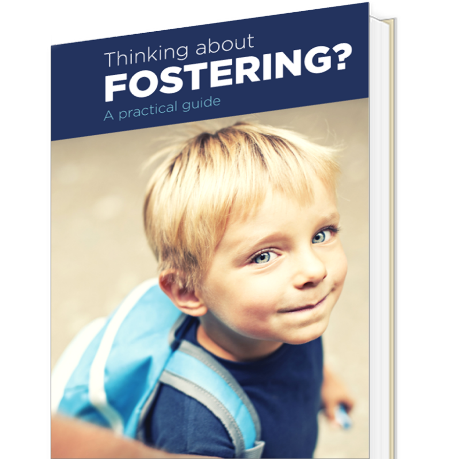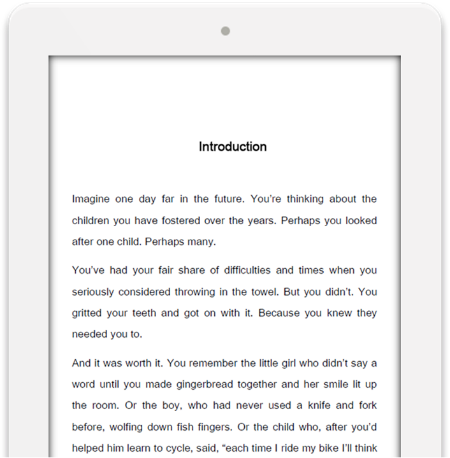What you will learn
Who can foster
The truth about who can and can't foster, plus the skills and qualities you'll need
How to apply
Choosing who to work for and the steps to becoming a foster carer
Types of fostering
From emergency to long-term foster care, there are many options to choose from
What to expect
The unexpected! What it's like when a child comes to live with you
What foster carers do
Why some children need foster care and how foster carers help them
Support and training
Who you'll work with and the support and training you'll receive
What foster carers say
One of the best ways to find out what fostering’s really like is to talk to the people actually doing it. In the book, foster carers share their reasons for fostering, the challenges they’ve faced and the rewards they’ve experienced. (Images of models have been used to protect foster carers’ identities)

June
I do it because this is my calling.

David
I look after teenagers. It’s the age group where I feel I can make the most significant difference. It’s a question of taking time to gain their trust. Through perseverance and showing that you care, you can make small inroads. They might put on a hard attitude but deep down, like everyone else, they just want to be liked.

Adele
If people have the skills and the patience and fostering was something they knew enough about to make an educated decision then I’d say do it. It’s the best thing I’ve ever done. It’s been very challenging but then I like a challenge and I’d never go back.

Natalie
Probably the hardest thing we had to do was to make the decision to foster in the first place. It felt like we were taking a leap of faith. But once we’d made the decision, it felt much better. We realised we could do it.

Claire
I went into fostering thinking, ‘here are these children who have been in this horrible situation. I will do all these nice things for them and make their lives so much better.’ And in turn, I guess I expected them to love me back or be happy that I was doing all this. I got the shock of my life.
Read a sample
Take a look inside to see if it’s the book for you.
What is fostering?
Think about a child you know. Perhaps your own son or daughter or a grandchild, a niece or nephew. Maybe the child of a friend. Imagine they can’t live at home for some reason and there’s no one amongst family or friends who can look after them.
Where will they live? Who will look after them? How will they be treated? How will they feel?
It’s unsettling, isn’t it, to contemplate any child we know being in this situation? We worry about how upset they would be, being separated from their family, how confused and anxious it might make them. We want them to be protected from harm. Most of all, we hope that they are living with caring, sensitive people who will support them through this difficult time, help them to enjoy life and reassure them about what’s happening.
In other words, we hope they’re in the care of really good foster carers.
You may or may not already know a child who’s in this situation. But every day around 62,000 children in the UK are living with foster carers. They need the same thing your imagined child does – a safe place to live, care, attention, reassurance, consistency and stability. And that is what foster care provides.
This chapter addresses in detail what fostering actually is, the organisations that are involved in making sure vulnerable children get the care they need and the role of the foster carer.
Types of fostering
Children come into foster care with very different needs. They might need somewhere to stay in an emergency – perhaps if a parent has gone into hospital suddenly and there’s nowhere else they can go. They might, in these circumstances, only need fostering for a few days or weeks. Other children might need support for longer periods, for instance in cases where suspected abuse is being investigated. Some children will be unable to return to their own families at all. They might need fostering for the rest of their childhood or need supporting until suitable adoptive parents are found for them.
The age of the child (ranging from 0 to 18) when they come into care, whether they have brothers and sisters and whether they have any special needs will also make a significant difference to the sort of care and the skills needed to support them.
All of this means that fostering agencies have to provide a range of different types of fostering in order to meet children’s diverse and sometimes complex needs. This chapter looks at the range of options available and how the decision is made about which type of fostering is right for you.
Becoming a foster carer
Foster care is such a crucial role it’s vital that fostering agencies do everything they can to ensure that foster carers have the time, space and ability to do it well.
That’s why there is a rigorous assessment process that all prospective foster carers must complete. This process has been laid out by the Government so that all fostering agencies take the same tried and tested steps in assessing all potential foster carers.
Unlike most other jobs you might apply for, where it is your skills and experience that an employer is most interested in, there are many more factors to take into account with the role of foster carer. Given you’ll be taking a child or children into your home and looking after them 24/7, the assessment process also needs to be able to evaluate whether your home is suitable and that you have the time to care for them properly.
By building up a detailed picture of you, your family, your home and your lifestyle, the fostering agency will be able to evaluate whether a child would be safe and well looked after in your care as well as making sure you have the skills and the temperament to cope with the challenges this role can bring.
The Government has set a target that assessments should be completed within eight months. To the prospective foster carer this can feel like a frustratingly long time, but it’s worth remembering that this also gives you, the applicant, the time to get a detailed understanding of what being a foster carer entails and to develop some of the skills you’ll need.
This chapter will go through each stage of the assessment process in detail so that you know what to expect, what you’ll have to do and why.
Looking after a foster child
So you’ve been approved as a foster carer. Congratulations! But here, of course, is where the hard work really starts.
If you’ve no previous experience of fostering, then this might be the aspect you’re most anxious about. Perhaps you’re asking yourself what it’s going to be like having a foster child live with you, what sort of behaviour you might expect or what happens if the child just doesn’t like you.
These are all quite natural things to worry about but the key thing to remember as you’re reading this section is that you won’t have reached this stage without a lot of training and a lot of support. Pre-approval training will have helped increase your understanding of the realities of foster care and given you some tools to help. The assessment process itself will have taught you a lot about what’s involved and that you have the skills to do it – you wouldn’t be approved otherwise. And once you are approved, you’ll carry on learning and being supported with each foster child that’s placed with you. So you’ll be much more clued-up and confident than you might feel right now.
This chapter explores some of the realities of looking after a foster child. Starting with how a child is placed with you in the first place, it also covers what you can expect, the key aspects of looking after a foster child and your core responsibilities as a foster carer.
Choose a chapter
-
What is fostering?
-
Types of fostering
-
Becoming a foster carer
-
Looking after a foster child
Buy your copy now!
Thinking about fostering? is available as an ebook and in paperback.
Discounts are available for agencies wishing to purchase multiple copies. Contact me for more details...
Buy now!About the author

Emma Harding
Hello. I’m Emma, a freelance writer and project manager. I’ve spent much of the last 15 years helping people to understand what fostering is all about. Working with fostering services across the country, I’ve delivered many successful marketing campaigns to promote fostering and encourage people to think about becoming foster carers.
I think foster carers are amazing people. The challenges they face are as diverse as the children they care for but they are all united in wanting to make a real difference to children’s lives.
I hope this book helps more people to decide that they could foster so that more vulnerable children get the support they need.
For more information and examples of my work please visit hilltopfostering.co.uk


